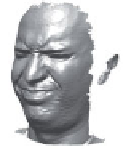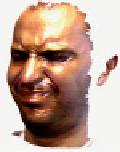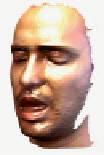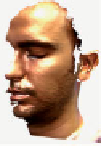Graphics Reference
In-Depth Information
(b)
(a)
Figure 5.8
(a) Deformations under facial expressions; (b) Missing data due to self occlusion
the bottom row in Figure 5.8
b
illustrates that dark areas (hair or eyebrows) absorb the laser
and generate missing data in the 3D mesh as illustrated at the top row of the same figure.
Additionally, variations in face data due to facial expressions cause deformations in the 3D
mesh. Figure 5.8
a
illustrates expressive faces at the bottom row (as 3D textured mesh). The
top row illustrates the resulting 3D mesh with deformations.
Any 3D face recognition approach should successfully match face scans in the presence
of expression-based deformations and/or missing data (as illustrated in Figs. 5.8
a,b
)toa
good quality, neutral, frontal 3D model. We note that generally the enrolled face scans are
collected in controlled conditions and exhibit good data quality. Past literature has tackled this
fundamental issue with varying degree of success as described in the survey paper by Bowyer
et al. (2006). In the following sections, we review some of the approaches addressing 3D face
recognition, grouping them according to the general idea addressed in 3D face representation.
5.3.2 3D Face Recognition: State of the Art
Among the various solutions that have appeared in recent years, we address methods that
are based on
geodesic measures
of the face,
deformable templates
, or the extraction of
local
regions/features
.
Geodesic-Based Approaches
In Bronstein et al. (2005), the authors presented an experimental validation of the isometric
model. They placed 133 markers on a face and tracked the change of both Euclidean and
geodesic distances under facial expressions. The distribution of the absolute change of geodesic
distances was closer to zero than the distribution of the change of Euclidean distance. Therefore,
the authors assumed that the change of geodesic distance is insignificant and concluded
that geodesic distance remains unchanged under facial expression. Under this assumption
Bronstein et al. (2005) corresponded the geodesic distance between the corresponding points











